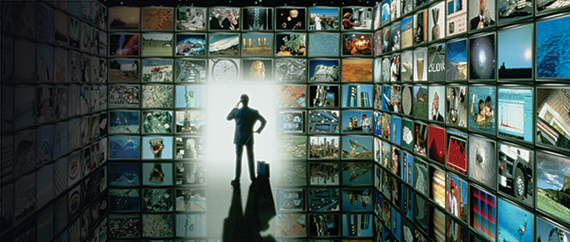 New Scientist is the UK’s leading science and technology weekly magazine and a sister publication to Estates Gazette. Its columnist Geoff Manaugh explores how technology and design is changing our cities, homes and ourselves
New Scientist is the UK’s leading science and technology weekly magazine and a sister publication to Estates Gazette. Its columnist Geoff Manaugh explores how technology and design is changing our cities, homes and ourselves

In a 1963 short story called The Walls, science fiction author Keith Laumer writes of a young husband whose enthusiasm for consumer electronics brings emotional ruin to his wife, Flora. Flora is forced to bear the brunt of her husband Harry’s need for ever-more intense audio-visual stimulation, which radically transforms their cramped urban home.
By installing a cube of full-wall flat-screen television panels – one on every side of their living room – Harry seeks a level of media saturation so complete that it is as if the original room is no longer there.
Flora, however, finds the transformation vertiginous. The apartment seems both infinite and constricting, annihilating her sense of where the full-wall ends and reality begins.
With the Oculus Rift and HTC Vive now here and Microsoft’s HoloLens on its way, consumer virtual reality has arrived.
The excitement around the technology brought Laumer’s story to mind. As Harry and Flora found, VR could have a big impact on our home life. Ultimately, it may force us to rethink what we want from our homes and workplaces.
Incorporating virtual objects, people and places into our homes and offices will require actual space; space for visual projection and physical interaction that allow virtual worlds to come to life. With applications that blend the real and virtual – as with the HoloLens – you need empty space for the virtual to appear within. You also need adequate space – reports are coming in of people injuring their hands playing VR game Selfie Tennis when overhead racket swings connect with non-virtual ceilings.
Let us assume that you don’t have a giant empty room in your house just waiting to become your own personal holodeck,” Wes Fenlon, PC Gamer
VR could push interior design even further towards minimalism – a blank canvas on which to paint the worlds that are not really there.
In fact, those most prepped for VR may be those of us who already embrace the kind of lifestyle advocated by Marie Kondo, who champions what she calls “the life-changing magic of tidying up”. Kondo prescribes a pruning of possessions to free up space and end the supposed distraction imposed by clutter. Welcoming VR into our homes and commercial buildings will require a similar effort.
As Fenlon has fun pointing out, the VR boom is a perfect excuse for decluttering – getting rid of furniture, rugs and cables you might trip on, and even taking pictures down from your walls so you don’t knock them off. Most VR experiences also require you to stand. So Fenlon recommends purchasing a standing desk in your office and anti-fatigue mats, instead of carpeting, to help ease the hours you will be spending on your feet.
It is partly tongue-in-cheek, of course. But Oculus is not joking in its Rift headset guidelines when it warns users to “remember that the objects you see in the virtual environment do not exist in the real environment, so don’t sit or stand on them or use them for support”. A viral video showing a person wearing a VR headset headbutt the floor as they try to look through a virtual trapdoor goes to show that many of us need reminding.
Oculus would not have to warn us if the temptation to interact with the virtual did not exist. But we are all too easily tricked into confusing what is and isn’t real. As we declutter, it is worth remembering Flora’s fate. She begins to find the world of screens impossible to escape and can no longer tell whether what she sees is taking place in a neighbour’s apartment or on TV.
That’s not to take away from the fact that VR tech is a marvel. But maybe we should pause before throwing everything out. If the power cuts out, we will all be left wondering where the furniture went.
• This article was first printed in New Scientist: www.newscientist.com
EG’s technology special features some of the biggest, newest and most respected names in technology. Each week, we look at the rise of proptech and its impact on this business. Visit editorial.property.rbi.web.ds/news/technology for more, and let us know of the trends and transformations we should be covering
• To send feedback, e-mail Samantha.McClary@estatesgazette.com or tweet @Samanthamcclary or @estatesgazette











